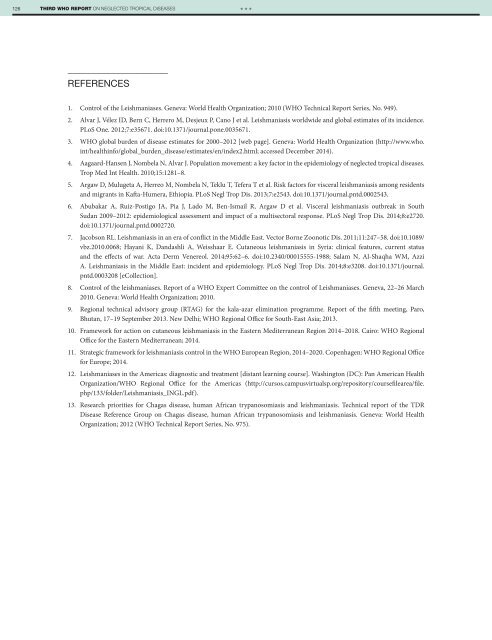1A9bnbK
1A9bnbK
1A9bnbK
You also want an ePaper? Increase the reach of your titles
YUMPU automatically turns print PDFs into web optimized ePapers that Google loves.
126 THIRD WHO REPORT ON NEGLECTED TROPICAL DISEASES<br />
***<br />
_____________________<br />
REFERENCES<br />
1. Control of the Leishmaniases. Geneva: World Health Organization; 2010 (WHO Technical Report Series, No. 949).<br />
2. Alvar J, Vélez ID, Bern C, Herrero M, Desjeux P, Cano J et al. Leishmaniasis worldwide and global estimates of its incidence.<br />
PLoS One. 2012;7:e35671. doi:10.1371/journal.pone.0035671.<br />
3. WHO global burden of disease estimates for 2000–2012 [web page]. Geneva: World Health Organization (http://www.who.<br />
int/healthinfo/global_burden_disease/estimates/en/index2.html; accessed December 2014).<br />
4. Aagaard-Hansen J, Nombela N, Alvar J. Population movement: a key factor in the epidemiology of neglected tropical diseases.<br />
Trop Med Int Health. 2010;15:1281–8.<br />
5. Argaw D, Mulugeta A, Herreo M, Nombela N, Teklu T, Tefera T et al. Risk factors for visceral leishmaniasis among residents<br />
and migrants in Kafta-Humera, Ethiopia. PLoS Negl Trop Dis. 2013;7:e2543. doi:10.1371/journal.pntd.0002543.<br />
6. Abubakar A, Ruiz-Postigo JA, Pia J, Lado M, Ben-Ismail R, Argaw D et al. Visceral leishmaniasis outbreak in South<br />
Sudan 2009–2012: epidemiological assessment and impact of a multisectoral response. PLoS Negl Trop Dis. 2014;8:e2720.<br />
doi:10.1371/journal.pntd.0002720.<br />
7. Jacobson RL. Leishmaniasis in an era of conflict in the Middle East. Vector Borne Zoonotic Dis. 2011;11:247–58. doi:10.1089/<br />
vbz.2010.0068; Hayani K, Dandashli A, Weisshaar E. Cutaneous leishmaniasis in Syria: clinical features, current status<br />
and the effects of war. Acta Derm Venereol. 2014;95:62–6. doi:10.2340/00015555-1988; Salam N, Al-Shaqha WM, Azzi<br />
A. Leishmaniasis in the Middle East: incident and epidemiology. PLoS Negl Trop Dis. 2014;8:e3208. doi:10.1371/journal.<br />
pntd.0003208 [eCollection].<br />
8. Control of the leishmaniases. Report of a WHO Expert Committee on the control of Leishmaniases. Geneva, 22–26 March<br />
2010. Geneva: World Health Organization; 2010.<br />
9. Regional technical advisory group (RTAG) for the kala-azar elimination programme. Report of the fifth meeting, Paro,<br />
Bhutan, 17–19 September 2013. New Delhi; WHO Regional Office for South-East Asia; 2013.<br />
10. Framework for action on cutaneous leishmaniasis in the Eastern Mediterranean Region 2014–2018. Cairo: WHO Regional<br />
Office for the Eastern Mediterranean; 2014.<br />
11. Strategic framework for leishmaniasis control in the WHO European Region, 2014–2020. Copenhagen: WHO Regional Office<br />
for Europe; 2014.<br />
12. Leishmaniases in the Americas: diagnostic and treatment [distant learning course]. Washington (DC): Pan American Health<br />
Organization/WHO Regional Office for the Americas (http://cursos.campusvirtualsp.org/repository/coursefilearea/file.<br />
php/133/folder/Leishmaniasis_INGL.pdf).<br />
13. Research priorities for Chagas disease, human African trypanosomiasis and leishmaniasis. Technical report of the TDR<br />
Disease Reference Group on Chagas disease, human African trypanosomiasis and leishmaniasis. Geneva: World Health<br />
Organization; 2012 (WHO Technical Report Series, No. 975).


